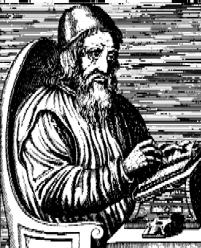






New books

Our CD
Top 20
|
In 1453, Constantinople fell to the Turks, ending the Byzantine empire.
This date also marks the beginning of the Renaissance, since the waves
of Greek refugees spread knowledge of Greek throughout Europe.
Included with the newly available Greek manuscripts were the Corpus Hermetica,
Plotinus, and the works of the Neoplatonists.
Shortly thereafter in 1492, Isabella and Ferdinand expelled the Jews from
Spain. This sent waves of Jewish refugees throughout Europe, spreading
knowledge of Hebrew and of the Kabbalah.
Renaissance philosophers sought to integrate these traditions with the
view of unifying the rapidly disintegrating religious factions and also
ending the constant political strife. Thus they are the forerunners or
prophets of the Rosicrucian and Illuminati movements.
 Johannes Trithemius (1462-1516)
Johannes Trithemius (1462-1516)
Master cryptographer and magician, Trithemius was the mentor of
Henrich Cornelius Agrippa.
 Heinrich Agrippa
Heinrich Agrippa
The most influential writer of renaissance esoterica.
Athanasius Kircher
|
 Dr. John Dee (1527-1608)
Dr. John Dee (1527-1608)
Another influential Renaissance figure, Dee was Queen Elizabeth's
scientific advisor. In later life, he became disillusioned with
pure science and started experimenting with occult techniques of the
day. Many of his esoteric writing were kept secret and only discovered
by accident long after his death.
|
 Giordano Bruno (1548-1600)
Giordano Bruno (1548-1600)
Bruno was one of the most original and colorful thinkers of the Renaissance.
The Inquisition considered him a dangerous heretic, and had him burned
at the stake in 1600.
|
Classical Grimoires
- Peter de Abano, Heptameron, or Magical Elements (Latin with English translation)
- Abramelin, Book of the Sacred Magic
- (Pseudo-)Albertus Magnus, Egyptian Secrets for Man and Beast

- Heinrich Cornelius Agrippa, Of
Occult Philosophy I: Natural Magic
- Heinrich Cornelius Agrippa, Of
Occult Philosophy II: Celestial Magic
- Heinrich Cornelius Agrippa, Of
Occult Philosophy III: Ceremonial Magic
- Heinrich Cornelius Agrippa, Fourth
Book of Occult Philosophy
- Arbatel of Magic
First appearing in Latin in 1575, this book focuses on
calling the 'olympick' spirits or angels. Known and used by
John Dee.
- Book of Protection,
Hermann Gollancz (1912)
- Armand Delatte: Anecdota Atheniensia: Containing the
text of a large number of magical manuscripts, including the Magical Treatise of Solomon (in GREEK)
- Honorius of Thebes: Liber Juratus, or the Sworn Book of Honorius.
This thirteenth century Grimoire is one of the foundation works of European magical
practice. It was one of Dr. Dee's sources for the Sigillum Dei Aemeth.
- Key of Solomon
This is the most famous and influential handbook of magic. Mathers' edition.
- The Key of Knowledge. A Sixteenth-Century
English translation of the Key of Solomon.
- The Clavicle of Solomon, revealed by Ptolomy the Grecian. (Sloane 3847)
- Clavicules du Roi Salomon, Par Armadel. Livre Quatrieme. Des Esprits qui gouvernent sous les Ordres du Souverain Createur.
(The Key of King Solomon, Book 4: The Spirits which govern under the Orders of the sovereign Creator.) (Excepts, French)
- The Veritable Clavicles of Solomon,
Translated from Hebrew into the Latin Language by Rabbi Abognazar (Lansdowne MS. 1203).
- Lemegeton:
This famous 16-17th century grimoire was compiled from earlier texts.
It was considered important by Crowley, Mathers, Waite, and others.
The scrying methods correspond closely with Dee's.
- Ars Notoria This medieval Grimoire
is closely related to Liber Juratus. It centers around orations
which can impart instant knowledge of divine and human arts and sciences.
- The Magical Calendar
(Calendarium Naturale Magicum Perpetuum)
by Johann Baptista Großchedel. (excerpts)
- Paracelsus: Archidoxis of Magic (excerpts, French)
- Picatrix (The Goal of the Wise) pseudo-Majriti. (Summary)
- Romanus-Büchlein (German)

- Reginald Scot's collection of magical texts
A fine example of Elizabethan English
- A. W. Greenup: Sefer ha-Levanah -- The Book of the Moon (Hebrew)
- Ebenezer Sibly,
A New and Complete Illustration of the Occult Sciences, Book 4. (1795?)
Methods used for raising up and consulting Spirits are laid open,
including a general Display of the Mysteries of Witchcraft, Divination, Charms,
and Necromancy. Also includes an alchemical process for raising
the form of plants from their essences (ala Borelli).
- Mafteah Shelomoh / Clavicula Salomonis,
A Hebrew Manuscript Newly discovered and now described, by Hermann Gollancz (1903)
- Sepher Maphteah Shelomoh
(Book of the Key of Solomon) An exact facsimile of an original book of magic
in Hebrew, ed. by Hermann Gollancz, (1914)
- Sixth and Seventh Books of Moses
- Sword of Moses
Tenth century Hebrew handbook of magic
- Testament of Solomon
One of the oldest magical texts attributed to King Solomon, dating First to
Third Century A.D. Includes a catalog of demons summoned by King Solomon,
and how they can be countered by invoking angels and other magical
techniques.
- Theosophia Pneumatica.
|
Black Magic
|
Sigillum Dei Aemeth
Miscellaneous
|
|







 Johannes Trithemius (1462-1516)
Johannes Trithemius (1462-1516)
 Heinrich Agrippa
Heinrich Agrippa
 Dr. John Dee (1527-1608)
Dr. John Dee (1527-1608)
 Giordano Bruno (1548-1600)
Giordano Bruno (1548-1600)
